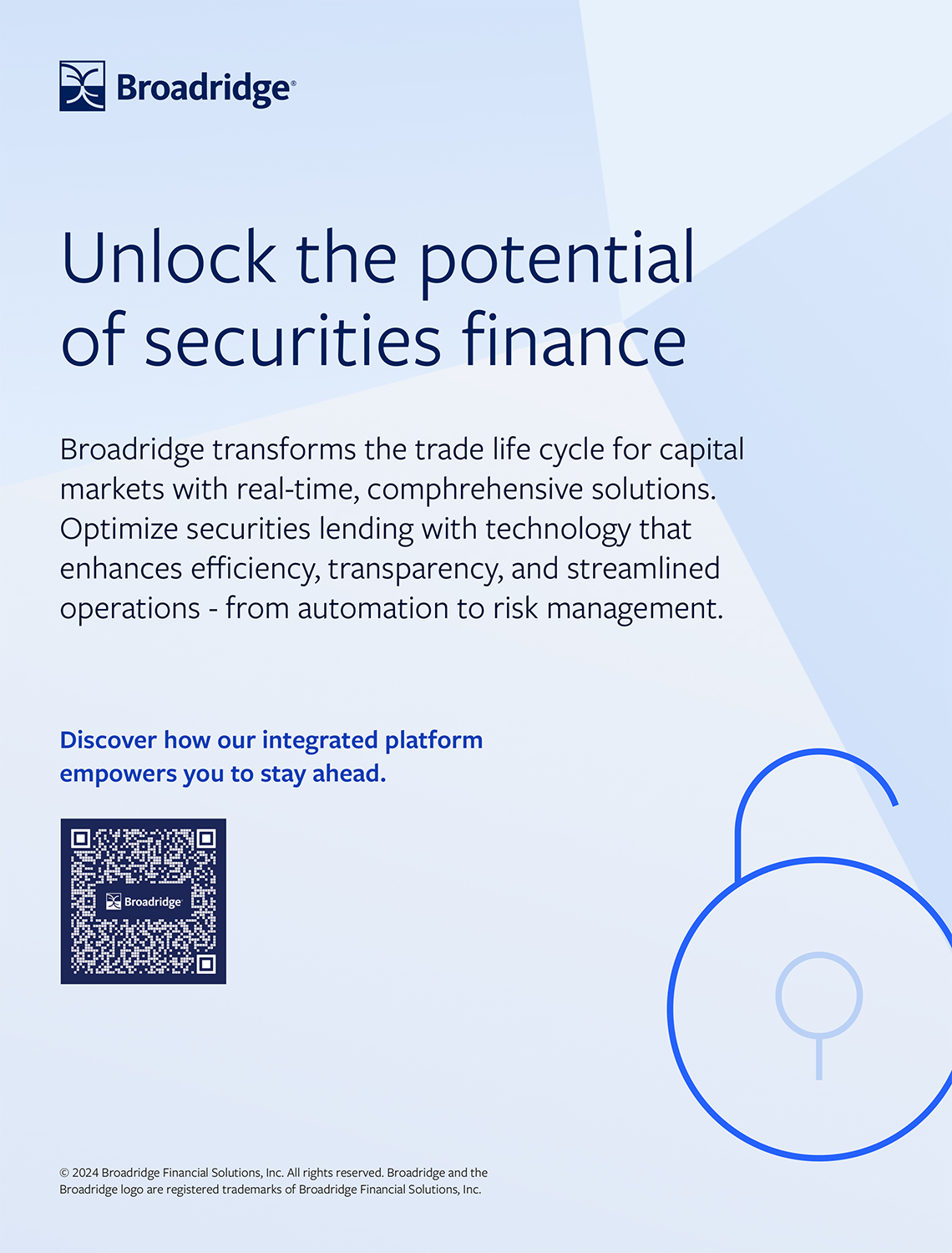HQLAᵡ goes live with first trades
03 December 2019 Luxembourg
 Image: Shutterstock
Image: Shutterstock
HQLAᵡ, the distributed ledger technology (DLT)-powered securities lending platform, is now live with UBS, Commerzbank, Credit Suisse and Eurex Repo F7 among the first to execute trades.
The HQLAᵡ platform offers collateral swaps by leveraging R3’s Corda DLT solution to provide liquidity and collateral management solutions for institutional clients in the global securities financing markets.
The solution is being jointly developed with Deutsche Boerse, which acquired a third tranche of shares of the platform earlier this year.
As part of HQLAᵡ’s first transactions, which took place in November, ownership of a basket of German government bonds and a basket of corporate bonds were swapped between UBS and Commerzbank, both using Clearstream Banking SA as custodian.
This was followed by a cross-custodian swap between UBS and Credit Suisse, in which ownership of a basket of corporate bonds at Clearstream Banking SA and a basket of German government bonds at Euroclear Bank were exchanged without the need for securities to be physically moved between the collateral agents, according to HQLAᵡ.
Instead, HQLAᵡ explained that the change in ownership was recorded on the digital collateral registry, which is one of the four layers of the HQLAᵡ operating model and was built on Corda Enterprise, the commercial distribution of R3’s blockchain platform.
Peter Schmidt, co-head, repo desk treasury at Commerzbank, described the platform as a “fascinating approach” to overcoming the fragmented post-trading landscape by significantly reducing the settlement cycle and avoiding resource-intensive collateral movements.
“It is a first but important step toward a new ecosystem where tokenised assets can be traded in a DLT environment,” he said.
Beyond those already trading, HQLAᵡ is engaged in on-boarding more than 15 other market participants including Citi, Goldman Sachs, ING and CIBC.
Elsewhere, J.P. Morgan is in the process of becoming the third triparty agent in the HQLAᵡ operating model, alongside Clearstream Banking S.A. and Euroclear Bank.
According to HQLAᵡ, this will add another custody/collateral location to the solution, thereby further increasing collateral mobilisation efficiencies for participants.
Of the platform’s go-live, HQLAᵡ’s CEO Guido Stroemer said: “The launch of our production platform is the culmination of strong collaboration, not only with our strategic partner Deutsche Boerse, but also with R3 and several global banks with which we began our journey less than three years ago in an R3 lab.
“Our mission statement from the very beginning has been to deliver solutions for specific pain points in the market, and so we worked very closely with a core group of banks to deliver an operating model that was designed by the market, for the market.”
How does HQLAᵡ work?
HQLAᵡ leverages a four-layer model that aims to facilitate more efficient collateral management of high-quality liquid assets, which are in heightened demand due to increased clearing and margin requirements of Basel III, among other regulations.
Layer one, which is built on Corda, is the digital collateral registry that enables delivery-versus-delivery ownership transfers of baskets of securities. HQLAᵡ explained that this eliminates the operationally onerous requirement to move securities across fragmented securities settlement systems.
The other layers are: the Eurex Repo F7-trading system, where transactions are executed; the participating custodians/triparty agents, where the securities are deposited; and the Deutsche Boerse-owned Trusted Third Party (TTP) entity, which links the custodians/triparty agents to the digital collateral registry.
The TTP acts as an interface between the HQLAᵡ digital collateral registry and existing securities settlement infrastructures.
In a statement on its launch, HQLAᵡ confirmed that it is already developing further functional enhancements and new business features, including digital collateral record re-use, intraday trades, delivery-versus-payment trades and support for various types of pledges.
The HQLAᵡ platform offers collateral swaps by leveraging R3’s Corda DLT solution to provide liquidity and collateral management solutions for institutional clients in the global securities financing markets.
The solution is being jointly developed with Deutsche Boerse, which acquired a third tranche of shares of the platform earlier this year.
As part of HQLAᵡ’s first transactions, which took place in November, ownership of a basket of German government bonds and a basket of corporate bonds were swapped between UBS and Commerzbank, both using Clearstream Banking SA as custodian.
This was followed by a cross-custodian swap between UBS and Credit Suisse, in which ownership of a basket of corporate bonds at Clearstream Banking SA and a basket of German government bonds at Euroclear Bank were exchanged without the need for securities to be physically moved between the collateral agents, according to HQLAᵡ.
Instead, HQLAᵡ explained that the change in ownership was recorded on the digital collateral registry, which is one of the four layers of the HQLAᵡ operating model and was built on Corda Enterprise, the commercial distribution of R3’s blockchain platform.
Peter Schmidt, co-head, repo desk treasury at Commerzbank, described the platform as a “fascinating approach” to overcoming the fragmented post-trading landscape by significantly reducing the settlement cycle and avoiding resource-intensive collateral movements.
“It is a first but important step toward a new ecosystem where tokenised assets can be traded in a DLT environment,” he said.
Beyond those already trading, HQLAᵡ is engaged in on-boarding more than 15 other market participants including Citi, Goldman Sachs, ING and CIBC.
Elsewhere, J.P. Morgan is in the process of becoming the third triparty agent in the HQLAᵡ operating model, alongside Clearstream Banking S.A. and Euroclear Bank.
According to HQLAᵡ, this will add another custody/collateral location to the solution, thereby further increasing collateral mobilisation efficiencies for participants.
Of the platform’s go-live, HQLAᵡ’s CEO Guido Stroemer said: “The launch of our production platform is the culmination of strong collaboration, not only with our strategic partner Deutsche Boerse, but also with R3 and several global banks with which we began our journey less than three years ago in an R3 lab.
“Our mission statement from the very beginning has been to deliver solutions for specific pain points in the market, and so we worked very closely with a core group of banks to deliver an operating model that was designed by the market, for the market.”
How does HQLAᵡ work?
HQLAᵡ leverages a four-layer model that aims to facilitate more efficient collateral management of high-quality liquid assets, which are in heightened demand due to increased clearing and margin requirements of Basel III, among other regulations.
Layer one, which is built on Corda, is the digital collateral registry that enables delivery-versus-delivery ownership transfers of baskets of securities. HQLAᵡ explained that this eliminates the operationally onerous requirement to move securities across fragmented securities settlement systems.
The other layers are: the Eurex Repo F7-trading system, where transactions are executed; the participating custodians/triparty agents, where the securities are deposited; and the Deutsche Boerse-owned Trusted Third Party (TTP) entity, which links the custodians/triparty agents to the digital collateral registry.
The TTP acts as an interface between the HQLAᵡ digital collateral registry and existing securities settlement infrastructures.
In a statement on its launch, HQLAᵡ confirmed that it is already developing further functional enhancements and new business features, including digital collateral record re-use, intraday trades, delivery-versus-payment trades and support for various types of pledges.
NO FEE, NO RISK
100% ON RETURNS If you invest in only one securities finance news source this year, make sure it is your free subscription to Securities Finance Times
100% ON RETURNS If you invest in only one securities finance news source this year, make sure it is your free subscription to Securities Finance Times



